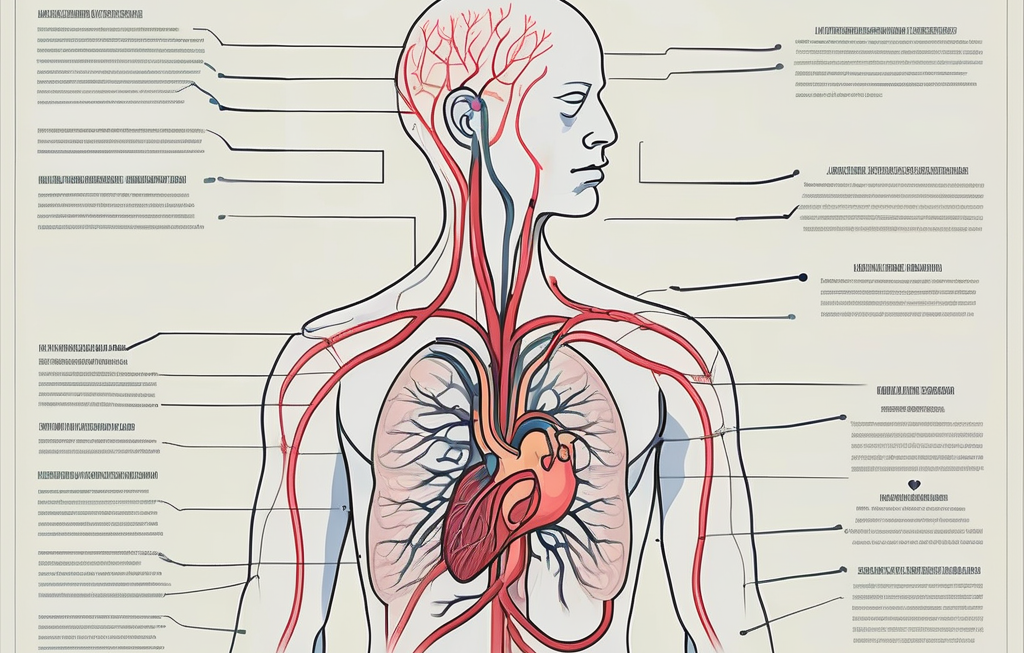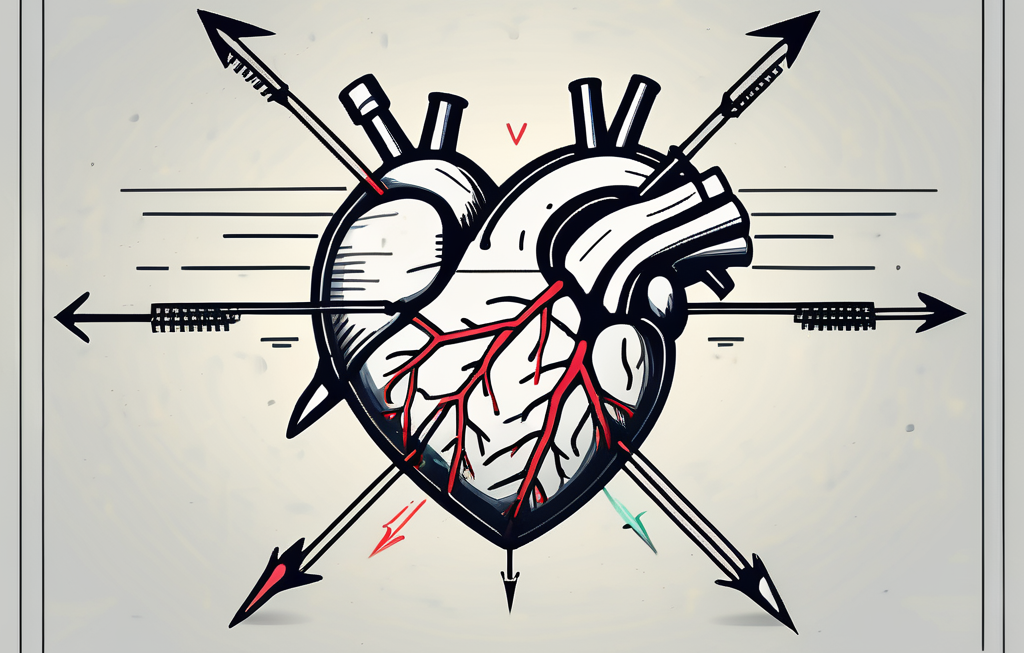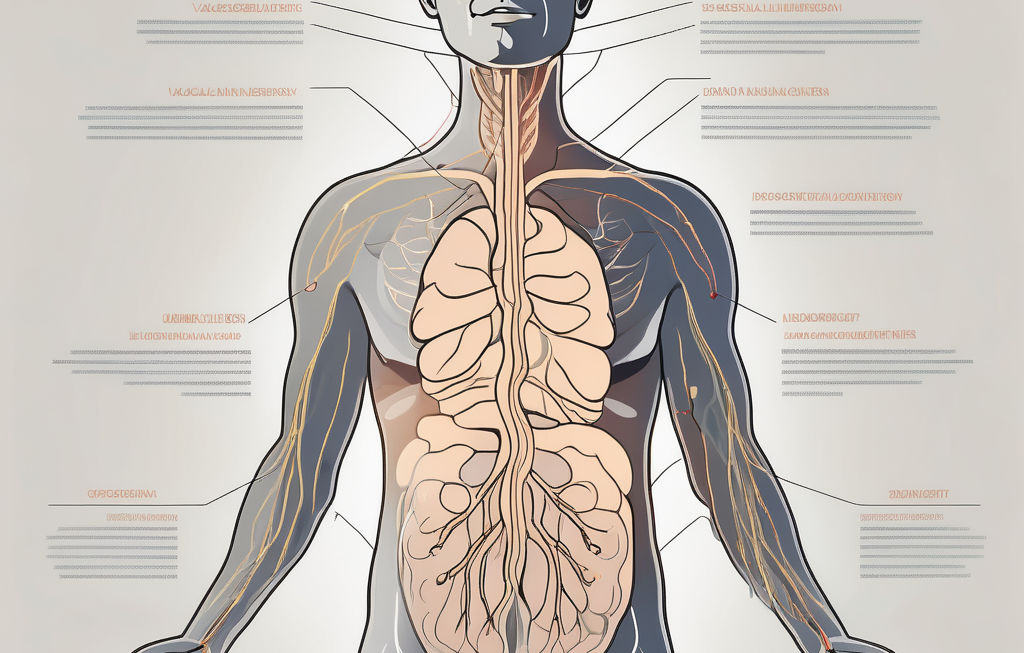Vagal maneuvers, also known as vagal stimulation techniques, are a group of non-invasive maneuvers used to regulate the heart rate and rhythm. These techniques work by stimulating the vagus nerve, which is a key player in the autonomic nervous system. Understanding the concept of vagal maneuvers is crucial for individuals seeking to explore alternative methods of managing certain heart conditions.
Understanding the Concept of Vagal Maneuvers
Before delving into the specifics of vagal maneuvers, it is important to have a clear understanding of the role of the vagus nerve in the body. The vagus nerve, also known as the cranial nerve X, is the longest cranial nerve in the human body. It originates in the brainstem and travels down to various organs, including the heart, lungs, and digestive system.
The primary function of the vagus nerve is to control the parasympathetic nervous system. This branch of the autonomic nervous system is responsible for regulating numerous involuntary bodily functions, such as heart rate, digestion, and respiratory rate. By stimulating the vagus nerve, vagal maneuvers can effectively influence the functioning of the parasympathetic nervous system and bring about specific physiological effects.
The Role of the Vagus Nerve in the Body
The vagus nerve acts as a communication pathway between the brain and the various organs it innervates. It transmits signals that regulate heart rate, conduction, and contractility. By exerting control over the heart’s electrical and mechanical activities, the vagus nerve plays a crucial role in maintaining cardiovascular stability.
Furthermore, the vagus nerve also plays a role in the regulation of digestion. It stimulates the release of digestive enzymes and increases the motility of the gastrointestinal tract. This ensures efficient digestion and absorption of nutrients.
The Basic Definition of Vagal Maneuvers
Vagal maneuvers encompass a range of techniques that aim to influence the functioning of the vagus nerve. These maneuvers typically involve specific physical actions or breathing exercises that stimulate the nerve and trigger a response in the parasympathetic nervous system.
One commonly used vagal maneuver is the Valsalva maneuver. This maneuver involves forcefully exhaling against a closed airway, such as by closing the mouth and pinching the nose. This increases the pressure in the chest, stimulating the vagus nerve and causing a decrease in heart rate.
Another vagal maneuver is the carotid sinus massage. This technique involves applying gentle pressure to the carotid sinus, a small area located in the neck where the carotid artery splits into two branches. By stimulating the carotid sinus, the vagus nerve is activated, leading to a decrease in heart rate and blood pressure.
The Different Types of Vagal Maneuvers
There are several different types of vagal maneuvers, each with its own unique method of stimulating the vagus nerve. Understanding these techniques is essential for individuals considering utilizing vagal maneuvers for their potential benefits.
Vagal maneuvers have been used for decades to manage various medical conditions, particularly those related to heart rhythm abnormalities. These maneuvers work by stimulating the vagus nerve, which plays a crucial role in regulating heart rate and other autonomic functions of the body. By understanding the different types of vagal maneuvers available, individuals can potentially harness the power of these techniques to help manage certain health issues.
The Valsalva Maneuver
The Valsalva maneuver is one of the most well-known vagal maneuvers. It involves forcefully exhaling against a closed airway, such as by pinching the nose or tightly closing the mouth. This action increases intra-abdominal pressure and stimulates the vagus nerve, leading to a reduction in heart rate.
While the Valsalva maneuver is commonly used to treat certain types of abnormal heart rhythms, it is important to perform this technique correctly to avoid potential complications. Improper execution of the maneuver can result in a sudden drop in blood pressure or even fainting. Therefore, individuals should always consult with a healthcare professional before attempting the Valsalva maneuver.
Carotid Sinus Massage
Carotid sinus massage involves gentle pressure applied to the carotid sinus, a baroreceptor located in the neck. This technique is performed by carefully manipulating the area just below the angle of the jaw. By activating the baroreceptor, carotid sinus massage triggers a reflex response that slows down the heart rate.
It is crucial to note that carotid sinus massage should only be performed by trained healthcare providers due to the potential risks involved. Incorrect application of pressure to the carotid sinus can lead to complications such as stroke or damage to the carotid artery. Therefore, individuals should never attempt carotid sinus massage without proper medical supervision.
Diving Reflex
The diving reflex is a vagal maneuver that leverages the body’s natural response to cold water immersion. This reflex is activated when the face is exposed to cold water, leading to a reduction in heart rate and blood pressure. This technique is often used in emergency situations or during certain medical procedures.
While the diving reflex can be a powerful tool in managing heart rate and blood pressure, it is essential to use caution when employing this technique. Prolonged exposure to cold water can have adverse effects on the body, including hypothermia and increased risk of cardiac events. Therefore, individuals should always seek guidance from healthcare professionals before utilizing the diving reflex as a vagal maneuver.
The Medical Applications of Vagal Maneuvers
Vagal maneuvers find application in various medical scenarios, including the treatment of rapid heart rate conditions and their use in diagnostic procedures.
Understanding the intricate mechanisms behind vagal maneuvers sheds light on their effectiveness in managing heart rhythm abnormalities. The vagus nerve, a key player in the parasympathetic nervous system, influences heart rate by releasing acetylcholine, which acts to slow down the heart’s electrical impulses. This physiological response can be harnessed through maneuvers like the Valsalva technique or carotid sinus massage to modulate heart rate and restore normalcy in cases of arrhythmias.
Treating Rapid Heart Rate Conditions
Vagal maneuvers can be employed as a first-line treatment for certain rapid heart rate conditions, such as supraventricular tachycardia (SVT). SVT is characterized by an abnormally fast heart rate originating from the upper chambers of the heart. Through their ability to slow down the heart rate, vagal maneuvers can sometimes help restore a normal rhythm and alleviate symptoms.
Moreover, the non-invasive nature of vagal maneuvers makes them a favorable option for managing SVT episodes, especially in outpatient settings. Patients can be educated on performing these maneuvers themselves, providing them with a sense of empowerment in managing their cardiac health.
Use in Diagnostic Procedures
Furthermore, vagal maneuvers are utilized in diagnostic procedures to aid in the identification and assessment of certain heart conditions. By inducing controlled changes in the heart’s electrical activity, these maneuvers can help physicians diagnose and evaluate the nature of an individual’s cardiac arrhythmias.
During an electrophysiology study, a healthcare provider may utilize vagal maneuvers to provoke specific arrhythmias, allowing for accurate mapping of the heart’s electrical pathways. This targeted approach aids in determining the most appropriate treatment strategy, whether it involves medications, catheter ablation, or implantable devices.
The Potential Risks and Side Effects of Vagal Maneuvers
While vagal maneuvers are generally safe and well-tolerated, certain precautions need to be taken to mitigate potential risks and side effects.
Vagal maneuvers are a group of techniques used to stimulate the vagus nerve, which can help regulate the heart rate in certain situations. These maneuvers are often employed in the management of supraventricular tachycardia (SVT) or to terminate episodes of paroxysmal supraventricular tachycardia (PSVT). One common vagal maneuver is the Valsalva maneuver, where the individual tries to exhale forcibly while keeping the mouth and nose closed, increasing the pressure in the chest cavity.
When Vagal Maneuvers Should Be Avoided
Individuals with certain medical conditions or risk factors should avoid performing vagal maneuvers without consulting a healthcare professional. These conditions include heart block, severe carotid artery disease, and a history of fainting or syncope.
It is crucial to recognize that vagal maneuvers can have differing effects on individuals based on their overall health status and medical history. For example, in patients with certain types of heart blocks, the use of vagal maneuvers can potentially worsen the conduction abnormality and lead to more serious cardiac complications.
Possible Complications and How to Mitigate Them
Although rare, complications can arise from vagal maneuvers. These may include lightheadedness, dizziness, or transient changes in blood pressure. To mitigate any potential complications, it is recommended to perform vagal maneuvers under the guidance of a healthcare provider.
Furthermore, individuals who are prone to vasovagal syncope (fainting due to a sudden drop in heart rate and blood pressure) should exercise caution when using vagal maneuvers, as these techniques can potentially trigger syncope episodes in susceptible individuals. Close monitoring and supervision by a healthcare professional can help ensure the safe and effective use of vagal maneuvers in clinical settings.
How to Perform Vagal Maneuvers Safely at Home
Vagal maneuvers can be performed safely at home with proper knowledge and precautions. However, it is essential to approach these techniques with caution and follow a step-by-step guide.
Precautions to Take Before Attempting Vagal Maneuvers
Prior to attempting any vagal maneuver at home, it is advisable to consult with a healthcare professional. They can assess your medical history and provide personalized guidance based on your specific needs and risks.
It is important to note that while vagal maneuvers are generally safe, they may not be suitable for everyone. Individuals with certain medical conditions, such as heart disease or a history of stroke, should exercise extra caution and seek medical advice before attempting these maneuvers. Additionally, pregnant women and individuals with certain respiratory conditions should also consult with a healthcare professional before trying vagal maneuvers at home.
Step-by-Step Guide to Performing Common Vagal Maneuvers
When performing vagal maneuvers at home, it is crucial to follow the correct technique to ensure effectiveness and safety. Here is a step-by-step guide to two common vagal maneuvers:
- The Valsalva Maneuver: Sit upright and take a deep breath. Pinch your nose or tightly close your mouth. Attempt to exhale forcefully while keeping your airway closed. Maintain this pressure for around 10-15 seconds. Release the pressure and breathe normally.
- Carotid Sinus Massage: Sit in a comfortable position and locate the carotid sinus in your neck, just below the angle of your jaw. Using your fingertips, apply gentle pressure to this area for 5-10 seconds. Be cautious not to apply excessive force or compress both sides at the same time.
Note: It is crucial to remember that vagal maneuvers should only be performed under the guidance of a healthcare professional. Self-diagnosis and self-treatment can lead to complications and may not be appropriate for everyone.
Furthermore, it is important to understand that vagal maneuvers are not a substitute for medical treatment. While they can be helpful in certain situations, such as managing certain types of abnormal heart rhythms, they should always be used in conjunction with medical advice and treatment. Your healthcare provider will be able to determine if vagal maneuvers are appropriate for your specific condition and provide guidance on when and how to use them.
By following these precautions and guidelines, you can safely perform vagal maneuvers at home. However, it is always best to consult with a healthcare professional to ensure that these techniques are suitable for your individual circumstances. Remember, your health and well-being should always be your top priority.
The Effectiveness of Vagal Maneuvers
The effectiveness of vagal maneuvers varies from individual to individual and is influenced by several factors. Vagal maneuvers are a set of simple techniques that can help regulate certain heart rhythm disturbances by stimulating the vagus nerve, which plays a key role in controlling the heart rate. These maneuvers are often used as a first-line treatment for conditions like supraventricular tachycardia (SVT) before resorting to medications or other interventions.
When performed correctly, vagal maneuvers can trigger a series of physiological responses that slow down the heart rate and restore normal rhythm. However, their success is not guaranteed for everyone, and understanding the factors that influence their effectiveness is crucial for optimizing their use in clinical practice.
Success Rates of Vagal Maneuvers
Studies have demonstrated varying success rates of vagal maneuvers in terminating certain heart rhythm disturbances. The effectiveness can range from approximately 20 to 70 percent, depending on the specific condition and the individual’s response. Factors such as the type of arrhythmia, the patient’s age, and the presence of underlying heart disease can all impact the success rate of vagal maneuvers. It is important for healthcare providers to assess each patient’s unique situation to determine the most appropriate course of action.
Factors Influencing the Effectiveness of Vagal Maneuvers
The success of vagal maneuvers can be influenced by factors such as the underlying heart condition, the duration and frequency of the arrhythmia, and individual physiological differences. Additionally, the technique used and the proficiency with which it is performed can also affect the outcome. Patients with certain heart conditions, such as atrial fibrillation, may be less responsive to vagal maneuvers compared to those with SVT. Furthermore, the timing of the maneuver in relation to the onset of symptoms can also play a role in its efficacy.
Future Research and Developments in Vagal Maneuvers
The field of vagal maneuvers continues to evolve, with ongoing research and innovations aiming to enhance their effectiveness and explore new applications.
Innovations in Vagal Maneuver Techniques
Researchers are continually exploring new vagal maneuver techniques or modifying existing ones to optimize their outcomes. These innovations may involve different positions, modified breathing techniques, or the incorporation of advanced technologies.
One promising area of innovation is the development of personalized vagal maneuver protocols. By tailoring these techniques to individual patients based on factors such as heart rate variability, respiratory patterns, and overall health status, researchers aim to maximize the therapeutic benefits of vagal maneuvers. This personalized approach holds great potential for improving treatment outcomes and patient experiences in the realm of cardiac care.
The Role of Vagal Maneuvers in Modern Medicine
As vagal maneuvers demonstrate their potential benefits, they are increasingly being recognized as a valuable adjunct to existing medical treatments. Further research is needed to expand our understanding of their efficacy and applicability across various cardiac conditions.
Moreover, the integration of vagal maneuvers into multidisciplinary treatment plans is gaining traction in modern healthcare settings. Collaborative efforts between cardiologists, neurologists, physiotherapists, and other healthcare professionals are being fostered to explore the comprehensive impact of vagal maneuvers on patient outcomes. This holistic approach not only enhances the quality of care but also opens up new avenues for interdisciplinary research and innovation in the field of cardiovascular health.
In conclusion, vagal maneuvers represent a non-invasive approach to manage certain heart rate conditions through the stimulation of the vagus nerve. Although they can offer significant benefits, caution must be exercised when performing vagal maneuvers, particularly in regards to medical history and individual suitability. It is always recommended to consult with a healthcare professional before attempting vagal maneuvers at home. By staying informed and following proper guidelines, individuals can explore the potential benefits of vagal maneuvers while prioritizing their safety and well-being.



